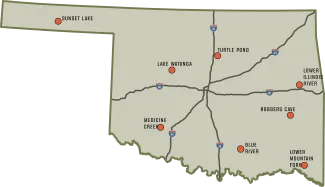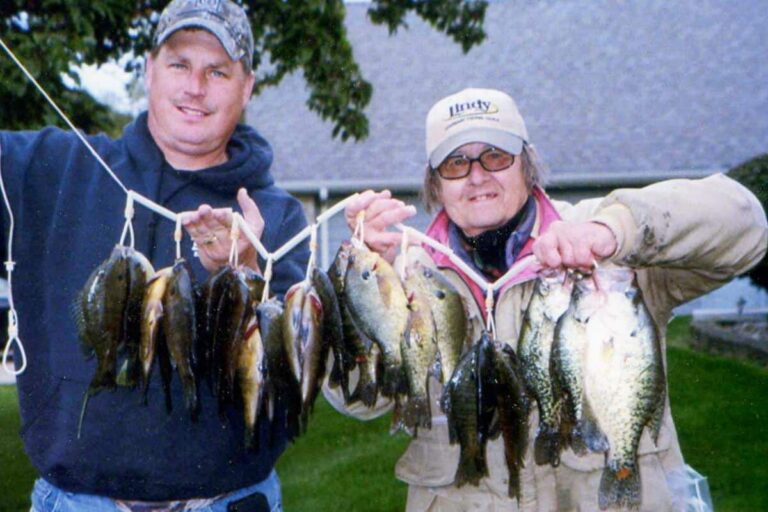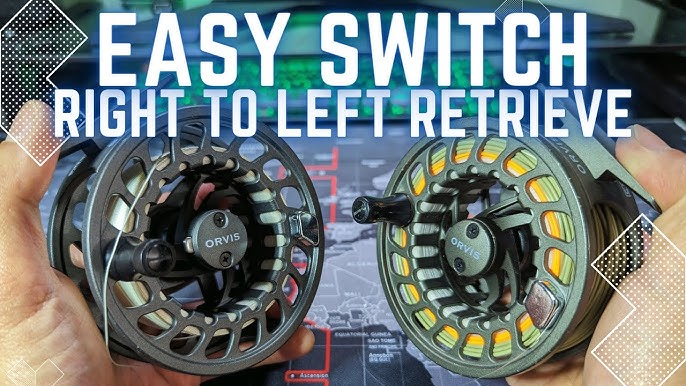Fishing in Oklahoma: Spots & Regulations Guide for Anglers
Fishing in Oklahoma offers diverse experiences for anglers. The state boasts a variety of spots and specific regulations.
Oklahoma is a hidden gem for fishing enthusiasts. With its numerous lakes, rivers, and streams, the state provides both novice and experienced anglers with ample opportunities. The thrill of catching bass, catfish, or trout draws many to these waters. But before you cast your line, it’s essential to know the rules.
Oklahoma’s fishing regulations ensure sustainable practices and protect the local fish populations. Understanding these guidelines will help you make the most of your fishing adventure. This blog will guide you through some of the best fishing spots and the key regulations you need to follow. Dive into this detailed guide to ensure a successful and enjoyable fishing trip in Oklahoma.
Top Fishing Spots
Oklahoma offers some of the best fishing spots in the United States. Anglers can enjoy a variety of experiences, from large lakes to serene rivers. Below are some top fishing spots that any fishing enthusiast should visit.
Lake Texoma
Lake Texoma is a popular fishing destination on the Texas-Oklahoma border. It is known for its abundant striper bass. This lake covers over 89,000 acres, providing ample space for fishing. Anglers also catch catfish, crappie, and largemouth bass here. The scenic views and rich wildlife make it a great spot for family trips.
Broken Bow Lake
Broken Bow Lake is nestled in the Ouachita Mountains. This clear-water lake is perfect for bass fishing. It spans 14,000 acres and is home to smallmouth and largemouth bass. Trout fishing is also popular in the nearby Mountain Fork River. The surrounding forest offers hiking and camping opportunities. This makes it an ideal spot for nature lovers.
Grand Lake
Grand Lake is a favorite among local anglers. It spans over 46,000 acres and is well-stocked with a variety of fish. The lake is known for its large population of catfish. Anglers can also find crappie, bass, and paddlefish. The area offers many marinas and fishing guides, making it accessible for beginners. The nearby town of Grove provides amenities and accommodations for visitors.

Credit: www.gameandfishmag.com
Family-friendly Locations
Fishing in Oklahoma offers a fantastic way for families to bond and enjoy nature. The state boasts several family-friendly locations perfect for anglers of all ages. These spots provide safe environments, ample fish, and scenic views.
Lake Thunderbird
Lake Thunderbird is a popular choice for family fishing trips. The lake’s calm waters are great for children learning to fish. Families can enjoy the clean, well-maintained shorelines. The lake is stocked with a variety of fish, including bass and catfish. There are picnic areas and playgrounds nearby, making it a perfect day out.
Lake Eufaula
Lake Eufaula is the largest lake in Oklahoma. This makes it ideal for family fishing adventures. The lake has several fishing docks that are safe for children. Families can catch crappie, bass, and catfish here. The surrounding area offers camping sites and trails. It’s an excellent spot for a weekend getaway.
Keystone Lake
Keystone Lake is another great family-friendly fishing location. The lake’s clear waters are home to various fish species. Families can fish for striped bass, catfish, and crappie. The lake has picnic areas and open spaces for children to play. It’s a serene spot for a relaxing fishing experience.
Best Seasons To Fish
Fishing in Oklahoma offers a unique experience throughout the year. Each season brings its own charm and opportunities. Let’s explore the best seasons to fish in Oklahoma.
Spring Fishing
Spring is one of the best seasons for fishing in Oklahoma. Fish become more active as the water warms up. Bass, crappie, and catfish are abundant. Lakes and rivers are full of life. It’s also the spawning season for many species. This makes it easier to catch fish near the shore.
Summer Fishing
Summer fishing in Oklahoma can be very rewarding. Early mornings and late evenings are the best times. Fish tend to stay in deeper waters during the hot midday. You can find bass, catfish, and sunfish. Use live bait or lures for better results. Many lakes and ponds are popular spots during summer.
Fall Fishing
Fall is a great time for fishing in Oklahoma. The temperatures start to cool down. Fish become more active again. Bass, catfish, and crappie are common catches. The fall foliage adds to the beauty of the fishing experience. It’s a peaceful time to enjoy nature and fishing.
Winter Fishing
Winter fishing in Oklahoma is for the hardy angler. Some fish like to stay in deeper waters. You can still catch catfish and bass. Ice fishing is possible on certain lakes. Make sure to check the ice thickness before going out. Dress warmly and bring hot drinks to stay comfortable.

Credit: www.visitokc.com
Popular Fish Species
Fishing in Oklahoma offers a diverse array of fish species. Anglers can find various fish to catch throughout the state. Whether you prefer lakes, rivers, or streams, there’s something for everyone. Let’s explore some of the popular fish species you can expect to reel in.
Bass
Bass fishing is a favorite activity in Oklahoma. You can find largemouth, smallmouth, and spotted bass in many lakes. The best times to catch bass are during spring and fall. Anglers often use lures, crankbaits, and live bait to attract bass. Popular spots include Grand Lake, Lake Eufaula, and Lake Texoma.
Catfish
Catfish are abundant in Oklahoma’s waters. Channel, blue, and flathead catfish are common catches. Catfishing is best during the warmer months. Night fishing can be particularly effective. Bait options include chicken liver, stink bait, and cut bait. Lake Tenkiller and the Arkansas River are great locations for catfish.
Trout
Trout fishing is a unique experience in Oklahoma. The state stocks rainbow and brown trout in several areas. Trout are usually found in cooler waters. The best time to fish for trout is during the cooler months. Fly fishing and using small lures can be effective. Popular trout fishing spots include the Lower Mountain Fork River and the Illinois River.
Crappie
Crappie fishing is popular among both novice and experienced anglers. Both black and white crappie are common in Oklahoma. Spring is the prime time for crappie fishing, especially during their spawning season. Small jigs and minnows are popular bait choices. Top locations for crappie include Lake Eufaula, Lake Thunderbird, and Kaw Lake.
Fishing Regulations
Oklahoma is a paradise for fishing enthusiasts. To ensure sustainable fishing practices, the state has specific regulations. These rules help maintain fish populations and protect the environment. Below, we discuss licensing requirements, bag limits, and size limits.
Licensing Requirements
In Oklahoma, a fishing license is mandatory for anyone aged 16 to 64. Licenses can be purchased online or at authorized retailers. Types of licenses include:
- Annual License: Valid for one year from the date of purchase.
- Five-Day License: Perfect for short trips.
- Lifetime License: For those who fish regularly.
Exemptions apply to residents under 16 or over 65, and certain disabled persons. Always carry your license while fishing.
Bag Limits
Bag limits control the number of fish an angler can keep in a single day. This helps prevent overfishing and ensures future generations can enjoy fishing.
| Fish Species | Daily Bag Limit |
|---|---|
| Trout | 6 |
| Catfish | 15 |
| Bass | 5 |
Check the Oklahoma Department of Wildlife Conservation (ODWC) website for updates.
Size Limits
Size limits ensure that young fish have the chance to grow and reproduce. Each species has its own size restrictions.
- Largemouth Bass: Minimum size 14 inches.
- Trout: No size limit, but daily bag limit applies.
- Catfish: Minimum size 12 inches.
Always measure your catch. Release fish that do not meet size requirements.
Catch And Release Guidelines
Fishing in Oklahoma offers a wide array of opportunities for anglers. Catch and release fishing helps maintain fish populations. It ensures the future of the sport. Here are some essential guidelines.
Handling Fish
Proper handling of fish is crucial. Wet your hands before touching the fish. This protects their slime coat. Keep the fish in the water as much as possible. Use a landing net with rubber mesh. This helps reduce injury to the fish.
Using Proper Gear
Using the right gear can make a big difference. Barbless hooks are recommended. They make it easier to release the fish. Use circle hooks. They reduce the chances of deep hooking. A de-hooking tool can help remove the hook safely.
| Gear Type | Benefits |
|---|---|
| Barbless Hooks | Easy removal |
| Circle Hooks | Reduces deep hooking |
| Rubber Mesh Net | Minimizes injury |
| De-hooking Tool | Safe hook removal |
Releasing Techniques
Releasing fish properly ensures their survival. Follow these steps:
- Hold the fish gently but firmly.
- Remove the hook quickly and carefully.
- Support the fish in the water until it swims away.
Avoid squeezing the fish. This can cause internal injuries. If a fish is exhausted, revive it by moving it back and forth in the water. This helps oxygenate its gills. Following these guidelines helps keep Oklahoma’s waters full of fish for future anglers.
Fishing Gear Essentials
Exploring the beautiful waters of Oklahoma for fishing can be an exciting adventure. To ensure a successful trip, having the right fishing gear is crucial. From rods and reels to bait and tackle boxes, each piece of equipment plays an essential role. Below, we dive into the must-have gear for an enjoyable fishing experience.
Rods And Reels
The rod and reel are the most important parts of your fishing gear. They come in various types, suited for different fishing styles and fish species. Here are some options:
- Spinning Rods: Great for beginners. Easy to use and versatile.
- Baitcasting Rods: Ideal for experienced anglers. Offers more control and power.
- Fly Rods: Perfect for fly fishing. Requires more skill but very rewarding.
Choosing the right reel is just as important. You have three main types:
- Spinning Reels: User-friendly, good for various fishing styles.
- Baitcasting Reels: Offers precision. Best for experienced fishers.
- Fly Reels: Designed for fly fishing. Balances the fly rod.
Bait And Lures
Using the right bait and lures can make a big difference. They attract fish and entice them to bite. Here are some common options:
| Bait | Best For |
|---|---|
| Live Bait | Catching a wide variety of fish. Very effective. |
| Artificial Lures | Targeting specific fish species. Reusable and less messy. |
Common types of lures include:
- Jigs: Great for many species. Mimics small prey.
- Spinners: Attracts fish with movement and flash.
- Crankbaits: Designed to look like small fish. Ideal for bass.
Tackle Boxes
A well-organized tackle box is essential for any fishing trip. It helps you keep all your gear in one place. Here are some tips for choosing and organizing your tackle box:
- Size: Ensure it’s big enough to hold all your gear.
- Compartments: More compartments help keep things organized.
- Durability: Choose a sturdy box that can withstand the elements.
Organize your tackle box by grouping similar items together. Keep your hooks, weights, and lures separate. This makes it easier to find what you need quickly.

Credit: www.wildlifedepartment.com
Safety Tips For Anglers
Fishing in Oklahoma offers many beautiful spots for anglers. Follow local regulations to ensure safety and protect the environment. Always check weather forecasts and wear life jackets.
Fishing in Oklahoma offers beautiful scenery and plenty of fish. But safety should always come first. Here are some essential safety tips for anglers.Weather Precautions
Check the weather forecast before heading out. Sudden storms can be dangerous. Wear appropriate clothing for the weather. Bring rain gear if necessary. Avoid fishing during thunderstorms. Lightning can pose a serious risk. If you hear thunder, seek shelter immediately. Always have a plan to leave quickly if weather conditions change.First Aid Kit
Carry a first aid kit with you. It should include bandages, antiseptics, and tweezers. Accidents can happen while fishing. Be prepared to treat minor injuries. Know how to use the items in your kit. Quick action can prevent infections. Keep your first aid kit in a waterproof container.Life Jackets
Always wear a life jacket when fishing from a boat. Even strong swimmers can face unexpected dangers. Choose a life jacket that fits well. Make sure it is Coast Guard approved. Children should wear life jackets at all times. Safety should never be compromised. Life jackets save lives.Frequently Asked Questions
Where Can I Fish In Oklahoma?
In Oklahoma, popular fishing spots include Lake Texoma, Grand Lake, and Broken Bow Lake. These locations offer diverse fishing opportunities for anglers.
What Are Oklahoma Fishing Regulations?
Oklahoma requires a fishing license for residents and non-residents. Regulations include size and bag limits for specific fish species. Always check current rules.
When Is The Best Time To Fish In Oklahoma?
Spring and fall are ideal for fishing in Oklahoma. During these seasons, fish are more active, increasing your chances of a successful catch.
Do I Need A License To Fish In Oklahoma?
Yes, a fishing license is required for both residents and non-residents in Oklahoma. Ensure you have the correct license before fishing.
Conclusion
Fishing in Oklahoma offers diverse spots and simple regulations. Enjoy clear lakes and peaceful rivers. Catch bass, catfish, or trout. Respect local rules to protect the environment. Bring family and friends for a fun day outdoors. Plan your trip well.
Oklahoma’s waters await. Happy fishing!



